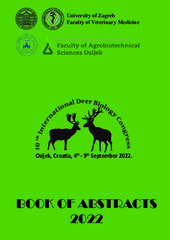Приказ основних података о документу
The giant liver fluke (Fascioloides magna) in Serbia
| dc.creator | Bugarski, Dejan | |
| dc.creator | Mirčeta, Jovan | |
| dc.creator | Stanojević, Slavoljub | |
| dc.creator | Đorđević, Milutin | |
| dc.creator | Nenadović, Katarina | |
| dc.creator | Ilić, Tamara | |
| dc.creator | Stankov, Branislav | |
| dc.date.accessioned | 2023-08-01T06:31:12Z | |
| dc.date.available | 2023-08-01T06:31:12Z | |
| dc.date.issued | 2022 | |
| dc.identifier.isbn | 978-953-8006-39-5 | |
| dc.identifier.uri | https://vet-erinar.vet.bg.ac.rs/handle/123456789/3044 | |
| dc.description.abstract | The giant liver fluke (Fascioloides magna) is present in the north-western region of the Republic of Serbia in a narrow area of floodplain forests along the watercourse of the Danube (approximately 130km long) and Sava rivers in the border region with Croatia. This region contains 5 hunting areas managed by state companies where the red deer population has a density from 2,03 to 12,39 animals per 100 ha. The first evidence of giant liver fluke in the Republic of Serbia is from 2008 in the northwestern part of the Danube river and the last region where fasciloidosis was observed is the border region with Croatia at the Sava river in 2012. Successful treatment of facioloidosis is partially limited by the selection of registered drugs. Regular treatment in affected hunting grounds is carried out by albendazole preparations in two manners: a mixture of albendazole in grain pellets given for 5 days and repeated after two weeks during February and March or a mixture of albendazole with salts given from February to July. Monitoring conducted over several hunting seasons shows that the presence of parasites has been confirmed in up to 80% of individuals, and 27% of individuals are newly infected annually. The maximum capacity of albendazole treatment is to reduce the presence of parasites at a level of 27% positive individuals. Additional attention is given to nearby hunting grounds where fascioloidosis is not yet present and the potential risks and influencing factors are considered. Regarding possible further spreading to the new areas, the main natural risk is the dispersion of metacercaria by rivers during high water levels or even flooding compared with possible migration routes of wild ruminants or the presence of free-living domestic ruminants on pastures. In 2020, a state program for the reintroduction of the red deer in southern parts of the country was implemented and increased the effort to create adequate quarantine measures, diagnostic, and treatment protocols as a measure to prevent the spread of giant liver fluke by human action. | sr |
| dc.language.iso | en | sr |
| dc.publisher | University of Zagreb, Faculty of Veterinary Medicine | sr |
| dc.rights | openAccess | sr |
| dc.rights.uri | https://creativecommons.org/licenses/by/4.0/ | |
| dc.source | 10th International Deer Biology Congress, Osijek, Croatia, 4th - 9th September 2022 | sr |
| dc.subject | red deer | sr |
| dc.subject | Fascioloides magna | sr |
| dc.subject | Serbia | sr |
| dc.subject | treatment | sr |
| dc.subject | epidemiology | sr |
| dc.subject | spreading | sr |
| dc.title | The giant liver fluke (Fascioloides magna) in Serbia | sr |
| dc.type | conferenceObject | sr |
| dc.rights.license | BY | sr |
| dc.citation.spage | 124 | |
| dc.citation.epage | 124 | |
| dc.description.other | Book of abstracts | sr |
| dc.identifier.fulltext | http://veterinar.vet.bg.ac.rs/bitstream/id/8981/bitstream_8981.pdf | |
| dc.identifier.rcub | https://hdl.handle.net/21.15107/rcub_veterinar_3044 | |
| dc.type.version | publishedVersion | sr |

